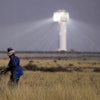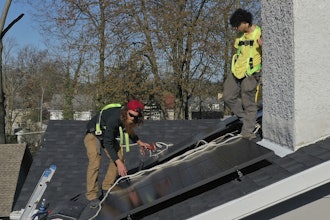According to the American Wind Energy Association (AWEA), U.S. wind energy installations now exceed 10,000 megawatts (MW) in generating capacity, and produce enough electricity on a typical day to power the equivalent of over 2.5 million homes. A megawatt of wind power generates enough to serve 250 to 300 average homes.
“Wind energy is providing new electricity supplies that work for our country’s economy, environment, and energy security,” said AWEA Executive Director Randall Swisher. “With its current performance, wind energy is demonstrating that it could rapidly become an important part of the nation’s power portfolio.”
The demand for wind as an energy source and concerns over the price and supplies of fuel are driving the record growth in wind power.
Industry growth has also been fueled by the timely renewal of the production tax credit (PTC), a federal incentive extended in the Energy Policy Act signed a year ago by President Bush. Previously, the credit had been allowed to expire three times in seven years, and this uncertainty discouraged investment in wind turbine manufacturing in the country.
AWEA is calling for a long-term extension of the PTC before its scheduled expiration at the end of 2007 to avoid further “on-again-off-again”cycles and encourage long-term investment.
The first commercial wind farms were constructed in California in the early 1980s, and after reaching 1,000 MW in 1985, it took more than a decade for wind to reach the 2,000-MW mark, in 1999.
Since then, however, installed capacity has grown fivefold. Today, the industry is installing more wind power in a single year (3,000 MW expected in 2006) than the amount operating in the entire country in 2000 (2,500 MW).
Wind was the second-largest source of new power generation in the U.S. in 2005 after natural gas, and is likely be so again in 2006, according to the Energy Information Administration.
Wind turbine manufacturing companies have recently opened facilities in Iowa (Clipper Windpower), Minnesota (Suzlon), and Pennsylvania (Gamesa), and wind turbine orders are creating jobs all the way down the supply chain, sometimes in areas that do not have a large wind resource, such as Louisiana.
Today’s 10,000 MW of wind power are keeping 16 million tons of carbon dioxide (CO 2), the leading greenhouse gas associated with global warming, out of the air every year. That’s equivalent to the amount of CO 2 that would be absorbed by over 9,000 square miles of forest, an area about the size of Vermont.
If the same amount of electricity as that generated by America’s 10,000-MW wind turbine fleet were instead produced using the average utility fuel mix, it would emit 73,000 tons of sulfur dioxide and 27,000 tons of nitrogen oxide per year, as well as other pollutants such as mercury.


















